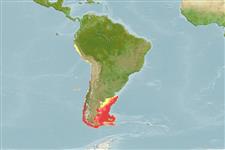Common names from other countries
Environment: milieu / climate zone / depth range / distribution range
Sinh thái học
gần đáy; Mức độ sâu 0 - 350 m (Ref. 275), usually 150 - 250 m (Ref. 106901). Subtropical, preferred 10°C (Ref. 107945); 3°S - 57°S, 81°W - 55°W (Ref. 275)
Southeast Pacific and Southwest Atlantic.
Length at first maturity / Bộ gần gũi / Khối lượng (Trọng lượng) / Age
Maturity: Lm ? range ? - ? cm Max length : 28.0 cm ML con đực/không giới tính; (Ref. 104650)
Inhabits the continental shelf (Ref. 106838). Found near the bottom. Undergoes horizontal ontogenetic migrations wherein juveniles move from spawning grounds in shallow, inshore waters at depths of 20 to 50 m, to offshore feeding grounds near the shelf edge at depths of 200 to 350 m. It then migrates back to inshore waters to spawn (Ref. 106901).
Life cycle and mating behavior
Chín muồi sinh dục | Sự tái sinh sản | Đẻ trứng | Các trứng | Sự sinh sản | Ấu trùng
Members of the class Cephalopoda are gonochoric. Male and female adults usually die shortly after spawning and brooding, respectively. Mating behavior: Males perform various displays to attract potential females for copulation. During copulation, male grasp the female and inserts the hectocotylus into the female's mantle cavity where fertilization usually occurs. Life cycle: Embryos hatch into planktonic stage and live for some time before they grow larger and take up a benthic existence as adults.
Roper, C.F.E., M.J. Sweeney and C.E. Nauen. 1984. (Ref. 275)
IUCN Red List Status (Ref. 130435)
CITES status (Ref. 108899)
Not Evaluated
Not Evaluated
Human uses
Các nghề cá: Tính thương mại
FAO - Các nghề cá: landings, species profile | FishSource | Biển chung quanh ta
Các công cụ
Các nguồn internet
Estimates based on models
Preferred temperature
(Ref.
115969): 4.4 - 12.7, mean 6 (based on 72 cells).
Thích nghi nhanh
Chiêù cao, thời gian nhân đôi của chủng quần tối thiểu là dưới 15 tháng (K=0.07-0.9).
Prior r = 0.48, 95% CL = 0.32 - 0.72, Based on 1 data-limited stock assessment.
Vulnerability
Low vulnerability (20 of 100).
